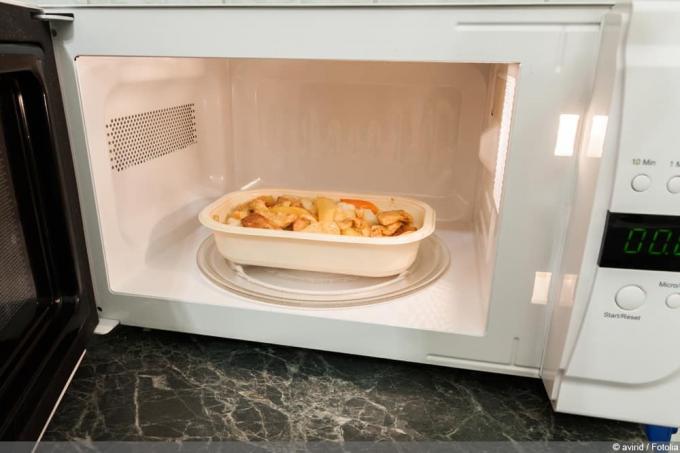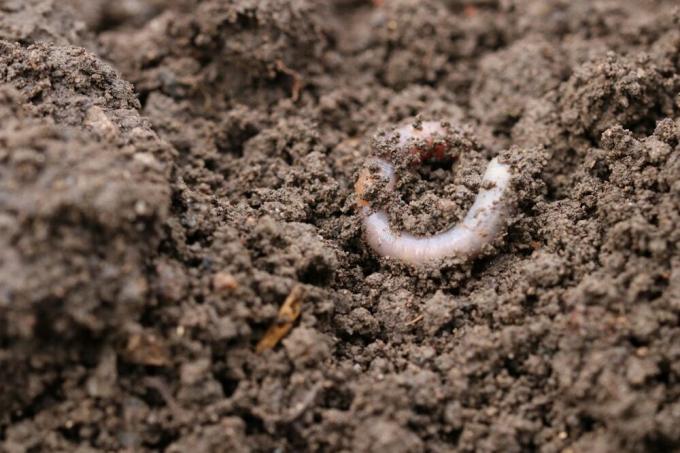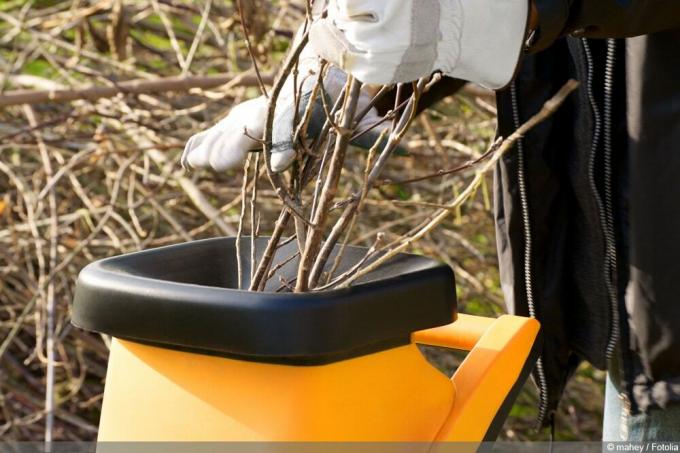

Table of contents
- Why should home gardeners sanitize soil?
- Moist heat kills pathogens
- Earth damper in wheelbarrow format
- Steaming Guide
- Steam compost in the oven
- Sterilize small quantities in the microwave
Soil-borne pathogens and pests make life difficult for plants. Almost invisible, viruses, bacteria, fungal spores and pests lurk in soil or compost as a massive threat to crop success. So that sowing and cultivation are not doomed to fail, knowledgeable home gardeners subject the substrate to an environmentally friendly soil decontamination using heat and steam. Read here why it is worth the effort to sterilize soil. A tried and tested guide explains how to steam compost correctly.
Why should home gardeners sanitize soil?
A wide range of soil-borne and root-infecting pests turns compost soil into a fatal source of infection. Numerous viruses make use of unrotted plant residues for explosive multiplication. Some particularly brazen bacteria can survive for a long time even without plant debris in the soil and lie in wait for suitable host plants. Last but not least, fungal spores use plant remains in the compost as a starting point for the infestation of plants used. Myriads of weed seeds or pest eggs that have nested in the substrate follow the same line.
Those who ignore the danger of contaminated compost soil leave their seedlings and plants vulnerable to the risk of infection by diseases or pests. Without prior treatment, vigorous weeds have an easy time of it and overgrow young plants in no time at all. When gardeners use natural methods to sterilize the soil, ornamental and vegetable plants can develop vigorously, healthily and undisturbed.
Moist heat kills pathogens
Natural home gardeners have banned chemical toxins from the garden and give priority to environmentally friendly methods of plant protection. This motto also applies to the destruction of pathogens and weed seeds in soil for sowing, bed and tub planting. Viruses, bacteria, fungal spores and the like have nothing to oppose moist heat. A study of the distinctively heat-resistant fungal spores of Fusarium oxysporum revealed where the so-called thermal inactivation point lies. Soil infected with the pathogens was sterile after heat treatment at 80 degrees Celsius. Experts conclude from this that most pathogens lay down their weapons at this temperature.
A temperature of 80 to 100 degrees Celsius alone is not sufficient for comprehensive thermal soil decontamination. The desired killing effect only occurs in combination with moisture. In the dry state, the germs to be combated can withstand much higher temperatures without being damaged. The third factor in the group is a sufficiently long exposure time of around 30 minutes. The attenuation should not be continued beyond this time in order to keep negative side effects to a minimum. It is important to note that damp heating also affects useful microorganisms.
Earth damper in wheelbarrow format
So that allotment gardeners can sterilize their home-made compost and bought-in soil, there is the earth damper in wheelbarrow format. The device is tailored to the needs in the home garden to disinfect up to 70 liters of substrate from pathogens of all kinds. The complete set consists of a wheelbarrow with steam generator, test thermometer, grating, jute filter and lid. The achievable steaming temperature is 80 degrees Celsius, which is the minimum requirement to render pathogens, pests and weed seeds harmless.

If the purchase price of 729 euros for a BEGA steam wheelbarrow is too high, you can use a BEGA earth steam pot. In it you can sterilize up to 25 liters of compost at 80 degrees Celsius, provided a heat source is available, such as a fireplace, gas or electric heating. For the price of 159 euros you get an aluminum pot with lid and perforated stainless steel plate. Of course, in order to sterilize up to 150 liters of soil or compost, you have to dig deep into your pocket. An appropriately dimensioned steam wheelbarrow costs a whopping 1,600 euros.
A notice:
Thermo composters are not suitable for soil decontamination using steam. Although high temperatures can develop inside, numerous ventilation slots prevent the necessary vapor from forming. Oxygen is vital for microorganisms and microorganisms that take care of the decomposition of the organic material.
Steaming Guide
If a soil steamer is available, you can sterilize soil and compost within minutes. Follow these steps to operate the device correctly:
- Fill with water, matched to the size of the wheelbarrow or pot
- Place the jute filter on the integrated grid
- Loosen up soil or compost and fill in
- attach the lid
- Switch on the device or place the pot on the heat source
- Steam for 30 minutes and keep an eye on the temperature
After half an hour of moist heat at 80 degrees Celsius on the substrate, not only are all pathogens destroyed. In addition, the earth is as open as after months of processing by busy soil organisms. Steaming makes nutrients and trace elements readily available to plants, from which seedlings and young plants benefit immediately.
Tip:
When steaming compost, effective nutrient compounds are quickly formed. When growing young plants, this concentrated load of plant energy is not always desirable. Enrich sterilized soil with at least a third of sand or coco coir to make it thin enough for seedling.
Steam compost in the oven
Investing in a steaming device is not always worthwhile for balcony gardeners. In order to make soil or compost sterile, the oven is quickly converted into a soil steamer. In these steps you can successfully disinfect substrate in the kitchen:
- Fill a fireproof bowl or deep baking tray 10 cm high with soil or compost
- Caution: Do not sterilize orchid soil in the oven due to the risk of fire
- Spray with a fine shower
- Lay the aluminum foil or lid loosely on top
- Preheat the oven to 80 to 100 degrees Celsius
Place the container or baking tray on the middle shelf of the oven. Close the door, because the supply of oxygen from outside prevents the formation of steam. After 30 minutes, turn off the oven, open the door and let the sterilized soil cool down. Are you bothered by the unpleasant smell that compost develops when steaming in the kitchen? Then put the earth in a roasting tube, which you place tightly closed on the baking sheet.
Sterilize small quantities in the microwave

Impatient home gardeners use the microwave to sanitize small amounts of substrate in minutes. For this purpose, fill compost soil in a microwave-safe container. Spray the substrate with water beforehand and put a lid on loosely. At 600 watts, the process is completed within 10 minutes. Open the microwave to allow the jar and steamed earth to cool.
 garden editorial
garden editorial I write about everything that interests me in my garden.
Learn more about making compost

Dampen the earth properly: build your own earth damper | sterilize compost
Sterilizing soil is a common practice that more and more home gardeners are embracing. This allows soil and especially compost to gain optimal quality. The gardening expert explains how to do it correctly and how easy it is to build an earth damper yourself.

Build your own worm box: Instructions | DIY worm composter
Building a worm box yourself is quite easy, but has numerous advantages. In our instructions we show how the DIY worm composter can be made with simple means and in just a few steps.

Build your own composter 12 tips for rain barrels, pallets & garbage cans
A composter is ideal for the garden and balcony. But the numerous options represent a hurdle. Each variant has its advantages. But no matter whether you build your own composter or buy it: there are some aspects that you should consider.

Balcony worm composter: Create compost on the balcony
Gardening is now done in the smallest of spaces, so growing vegetables on the balcony is no longer out of the question. However, a prerequisite for a good harvest is high-quality soil, which can be produced even in a limited space using vermicompost.

Shredding garden waste and hedge trimmings: which shredder is suitable?
Gardening results in branch cuttings and green waste that can either be disposed of or reused. With a garden shredder, the greens can be processed into compost or mulch and made available for garden use. There are various variants to choose from, which can be adapted to the intended use.

Build a pass-through sieve yourself | Mesh size for compost, soil and sand
In a well-equipped home garden, a pass-through sieve removes unwanted components from compost, soil and sand. With a little manual skill and these instructions, you can easily build a stable garden sieve yourself. You can find out here which mesh size guarantees perfect results.



